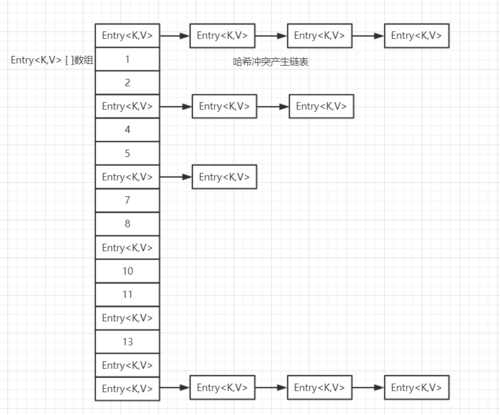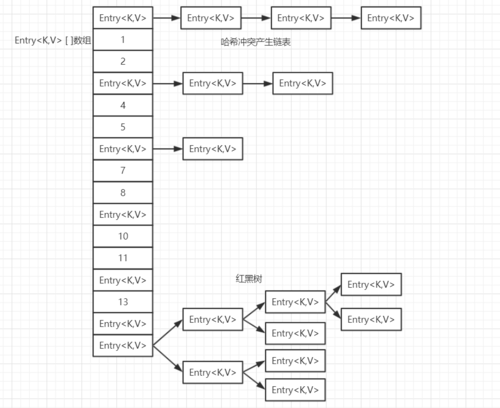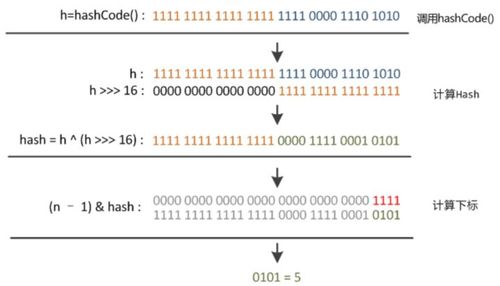概述
在上文我们基于JDK7分析了HashMap的实现源码,介绍了HashMap的加载因子loadFactor、阈值threshold概念以及增删元素的机制。JDK8在JDK7的基础上对HashMap的实现进行了进一步的优化,最主要的改变就是新增了红黑树作为底层数据结构。
HashMap数据结构
首先我们回忆一下JDK7中HashMap的实现,HashMap是以数组和单链表构成,当出现哈希冲突时,冲突的元素在桶中依次形成单链表,数据结构如下:
JDK7中哈希冲突时使用链表存储冲突元素,当出现大量哈希冲突元素,那么在单链表查找一个元素的复杂度为O(N),为了优化出现大量哈希冲突元素的查找问题,JDK8中规定:当单链表存储元素个数超过阈值TREEIFY_THRESHOLD(8)时,将单链表转换为红黑树,红黑树查找元素复杂度为O(logN),提高了查找效率,JDK8中HashMap的存储结构:
内部字段及构造方法
Node类
使用Node类存储键值对元素。
static class Node<K,V> implements Map.Entry<K,V> { final int hash; final K key;
V value;
Node<K,V> next;
Node(int hash, K key, V value, Node<K,V> next) { this.hash = hash; this.key = key; this.value = value; this.next = next;
}
}TreeNode类
TreeNode是构成红黑树的基本元素。
static final class TreeNode<K,V> extends LinkedHashMap.Entry<K,V> {
TreeNode<K,V> parent; // red-black tree links
TreeNode<K,V> left;
TreeNode<K,V> right;
TreeNode<K,V> prev; // needed to unlink next upon deletion
boolean red; //构造一个树结点
TreeNode(int hash, K key, V val, Node<K,V> next) { super(hash, key, val, next);
}
}内部字段
//数组初始容量,为16 static final int DEFAULT_INITIAL_CAPACITY = 1 << 4; // aka 16 //数组最大容量 static final int MAXIMUM_CAPACITY = 1 << 30; //默认加载因子 static final float DEFAULT_LOAD_FACTOR = 0.75f; //单链表转化为红黑树的阈值 static final int TREEIFY_THRESHOLD = 8; /** * 主要用于resize()扩容过程中, 当对原来的红黑树根据hash值拆分成两条链表后, * 如果拆分后的链表长度 <=UNTREEIFY_THRESHOLD, 那么就采用链表形式管理hash值冲突; * 否则, 采用红黑树管理hash值冲突. */ static final int UNTREEIFY_THRESHOLD = 6; /** * 当集合中的容量大于这个值时,表中的桶才能进行树化 ,否则桶内元素太多时会扩容, * 而不是树形化 为了避免进行扩容、树形化选择的冲突,这个值不能小于 4 * TREEIFY_THRESHOLD */ static final int MIN_TREEIFY_CAPACITY = 64; //第一次使用是初始化,数组长度总是2的幂次 transient Node<K,V>[] table; transient int size; int threshold; final float loadFactor;
构造方法
public HashMap(int initialCapacity, float loadFactor) { //检查参数合法性
if (initialCapacity < 0) throw new IllegalArgumentException("Illegal initial capacity: " +
initialCapacity); if (initialCapacity > MAXIMUM_CAPACITY)
initialCapacity = MAXIMUM_CAPACITY; if (loadFactor <= 0 || Float.isNaN(loadFactor)) throw new IllegalArgumentException("Illegal load factor: " +
loadFactor); this.loadFactor = loadFactor; //这里只是初始化,最终赋值在resize方法里
this.threshold = tableSizeFor(initialCapacity);
}哈希值与索引计算
hash(Object key)
在JDK1.8的实现中,优化了高位运算的算法,通过hashCode()的高16位异或低16位实现的:(h = k.hashCode()) ^ (h >>> 16),主要是从速度、功效、质量来考虑的,这么做可以在数组table的length比较小的时候,也能保证考虑到高低Bit都参与到Hash的计算中,同时不会有太大的开销。
这个方法非常巧妙,它通过h & (table.length -1)来得到该对象的保存位,而HashMap底层数组的长度总是2的n次方,这是HashMap在速度上的优化。当length总是2的n次方时,h& (length-1)运算等价于对length取模,也就是h%length,但是&比%具有更高的效率。计算过程如下图:
static final int hash(Object key) { int h; return (key == null) ? 0 : (h = key.hashCode()) ^ (h >>> 16);
} //jdk1.7的源码,jdk1.8没有这个方法,但是实现原理一样的
//根据hash值和table数组长度计算键值对存储位置的索引
static int indexFor(int h, int length) {
return h & (length-1); //第三步 取模运算
}存储元素
put(K key, V value)
public V put(K key, V value) { return putVal(hash(key), key, value, false, true);
} /**
* Implements Map.put and related methods
* @param hash hash for key
* @param key the key 键
* @param value the value to put 值
* @param onlyIfAbsent if true, don't change existing value 表示不要更改现有值
* @param evict if false, the table is in creation mode. false表示table处于创建模式
* @return previous value, or null if none
*/
final V putVal(int hash, K key, V value, boolean onlyIfAbsent, boolean evict) { //使用局部变量tab而不是类成员,方法栈上访问更快
Node<K,V>[] tab; Node<K,V> p; int n, i; //如果table为null或者长度为0,则进行初始化
if ((tab = table) == null || (n = tab.length) == 0) //扩容
n = (tab = resize()).length; //散列到对应的桶中,如果桶为空则直接放到桶中即可
if ((p = tab[i = (n - 1) & hash]) == null)
tab[i] = newNode(hash, key, value, null); else { //else分支表示散列到的桶中元素不为空
Node<K,V> e; K k; //桶中链表的根节点的key就是要插入的键值对的key
if (p.hash == hash &&
((k = p.key) == key || (key != null && key.equals(k))))
e = p; //如果是红黑树,插入到红黑树中
else if (p instanceof TreeNode)
e = ((TreeNode<K,V>)p).putTreeVal(this, tab, hash, key, value); //插入到单链表中
else { //遍历链表,并统计桶中键值对元素数量
for (int binCount = 0; ; ++binCount) { //该Key在链表中不存在,插入末尾 此时e为null
if ((e = p.next) == null) {
p.next = newNode(hash, key, value, null); //单链表元素个数超过TREEIFY_THRESHOLD,树化
if (binCount >= TREEIFY_THRESHOLD - 1) // -1 for 1st
treeifyBin(tab, hash); break; //注意从这里break出来的e为null
} //该Key已经在链表中
if (e.hash == hash &&
((k = e.key) == key || (key != null && key.equals(k)))) //注意从这里break出来的e不为null
break;
p = e;
}
} // e != null,说明该Key已经在存在于HashMap中,在这个桶中
if (e != null) { // existing mapping for key
V oldValue = e.value; //根据onlyIfAbsent和old
if (!onlyIfAbsent || oldValue == null)
e.value = value;
afterNodeAccess(e); return oldValue;
}
}
++modCount; //超过阈值,就进行扩容
if (++size > threshold)
resize();
afterNodeInsertion(evict); return null;
}扩容
resize( )
resize方法相对比较复杂,但是有比较巧妙,因为要考虑数据结构的不同怎么把元素从老的table中放到扩容后的table中。主要的思路也就是两步:先根据老的table的长度决定扩容后table的长度,以及新的阈值threshold;在桶中数据不为空的情况下,把桶中的数据迁移到新的table数组中,这里就要考虑在桶中只有一个元素(没有发生哈希冲突)、桶中元素以单链表形式存储(发生哈希冲突但是不超过8个)、桶中元素以红黑树形式存储(哈希冲突元素个数超过8个)。只有一个元素,直接根据哈希值和新的table数组长度计算出新的索引,红黑树调用split方法,这里我们重点分析一下怎么把桶中的单链表迁移到新桶中,从而体会到JDK的巧妙设计。
resize的扩容策略是每次扩容2倍(newThr = oldThr << 1),为了把单链表元素迁移到新的桶中,并不是向JDK7那样直接根据哈希值散列得到新的索引值,经过观测可以发现,我们使用的是2次幂的扩展(指长度扩为原来2倍),所以,元素的位置要么是在原位置,要么是在原位置再移动2次幂的位置。看下图可以明白这句话的意思,n为table的长度,图(a)表示扩容前的key1和key2两种key确定索引位置的示例,图(b)表示扩容后key1和key2两种key确定索引位置的示例,其中hash1是key1对应的哈希与高位运算结果。
元素在重新计算hash之后,因为n变为2倍,那么n-1的mask范围在高位多1bit(红色),因此新的index就会发生这样的变化:
因此,我们在扩充HashMap的时候,不需要像JDK1.7的实现那样重新计算hash,只需要看看原来的hash值新增的那个bit是1还是0就好了,是0的话索引没变,是1的话索引变成“原索引+oldCap”
final Node<K,V>[] resize() { //使用oldTab指向原来的hash表,通常方法内都使用局部变量,局部变量在方法栈上,而对象的成员在堆上
//方法栈的访问比堆更高效
//记录扩容前table数组,阈值,长度
Node<K,V>[] oldTab = table; int oldCap = (oldTab == null) ? 0 : oldTab.length; int oldThr = threshold; int newCap, newThr = 0; if (oldCap > 0) { //原来的容量已经很大了,超过了MAXIMUM_CAPACITY无法再调整
if (oldCap >= MAXIMUM_CAPACITY) {
threshold = Integer.MAX_VALUE; return oldTab;
} //容量加倍
else if ((newCap = oldCap << 1) < MAXIMUM_CAPACITY &&
oldCap >= DEFAULT_INITIAL_CAPACITY)
newThr = oldThr << 1; // double threshold
} //oldCap < 0,oldThr > 0,table空间尚未分配,初始化分配空间
//旧阀值大于0,则将新容量直接等于就阀值
else if (oldThr > 0) // initial capacity was placed in threshold
newCap = oldThr; //阀值等于0,oldCap也等于0(集合未进行初始化)
else { // zero initial threshold signifies using defaults
newCap = DEFAULT_INITIAL_CAPACITY; //threshhold=capacity*load_factor
newThr = (int)(DEFAULT_LOAD_FACTOR * DEFAULT_INITIAL_CAPACITY);
} //计算新的阀值上限
if (newThr == 0) { float ft = (float)newCap * loadFactor;
newThr = (newCap < MAXIMUM_CAPACITY && ft < (float)MAXIMUM_CAPACITY ?
(int)ft : Integer.MAX_VALUE);
}
threshold = newThr; @SuppressWarnings({"rawtypes","unchecked"})
Node<K,V>[] newTab = (Node<K,V>[])new Node[newCap];
table = newTab; //原来的表中有内容,表明这是一次扩容,需要将Entry散列到新的位置
if (oldTab != null) { for (int j = 0; j < oldCap; ++j) { //遍历所有bin
Node<K,V> e; if ((e = oldTab[j]) != null) { //旧桶中元素置为null,方便GC
oldTab[j] = null; //该桶中只有一个节点,直接散列到新的位置
if (e.next == null)
newTab[e.hash & (newCap - 1)] = e; else if (e instanceof TreeNode) //该桶中是一颗红黑树,通过红黑树的split方法处理
//待会再看split方法
((TreeNode<K,V>)e).split(this, newTab, j, oldCap); else { // preserve order
Node<K,V> loHead = null, loTail = null;
Node<K,V> hiHead = null, hiTail = null;
Node<K,V> next;
do {
next = e.next; // 与oldCap按位相与,判断结果是一还是零
if ((e.hash & oldCap) == 0) { if (loTail == null)
loHead = e; else
loTail.next = e;
loTail = e;
} else { if (hiTail == null)
hiHead = e; else
hiTail.next = e;
hiTail = e;
}
} while ((e = next) != null); //原索引
if (loTail != null) {
loTail.next = null;
newTab[j] = loHead;
} //原索引+oldCap
if (hiTail != null) {
hiTail.next = null;
newTab[j + oldCap] = hiHead;
}
}
}
}
} return newTab;
}删除元素
remove(Object key)
public V remove(Object key) {
Node<K,V> e; return (e = removeNode(hash(key), key, null, false, true)) == null ? null : e.value;
} final Node<K,V> removeNode(int hash, Object key, Object value, boolean matchValue, boolean movable) {
Node<K,V>[] tab; Node<K,V> p; int n, index; //tab不为空,p指向根据hash散列到桶中第一个节点
if ((tab = table) != null && (n = tab.length) > 0 &&
(p = tab[index = (n - 1) & hash]) != null) {
Node<K,V> node = null, e; K k; V v; //第一个节点就命中
if (p.hash == hash &&
((k = p.key) == key || (key != null && key.equals(k))))
node = p; else if ((e = p.next) != null) { //在红黑树中查找目标节点
if (p instanceof TreeNode)
node = ((TreeNode<K,V>)p).getTreeNode(hash, key); //在单链表中查找目标节点
else {
do { if (e.hash == hash &&
((k = e.key) == key ||
(key != null && key.equals(k)))) {
node = e; break;
}
p = e;
} while ((e = e.next) != null);
}
} //找到目标节点且符合移除的条件
if (node != null && (!matchValue || (v = node.value) == value ||
(value != null && value.equals(v)))) { //红黑树移除
if (node instanceof TreeNode)
((TreeNode<K,V>)node).removeTreeNode(this, tab, movable); //单链表移除
//移除的节点是单链表首节点
else if (node == p)
tab[index] = node.next; //移除的节点不是单链表首节点
else
p.next = node.next;
++modCount;
--size;
afterNodeRemoval(node); return node;
}
} return null;
}查找元素
get(Object key)
public V get(Object key) {
Node<K,V> e; return (e = getNode(hash(key), key)) == null ? null : e.value;
} final Node<K,V> getNode(int hash, Object key) {
Node<K,V>[] tab; Node<K,V> first, e; int n; K k; if ((tab = table) != null && (n = tab.length) > 0 &&
(first = tab[(n - 1) & hash]) != null) { //hash值对应的桶中第一个元素
//第一个元素符合查找条件
if (first.hash == hash && // always check first node
((k = first.key) == key || (key != null && key.equals(k)))) return first; if ((e = first.next) != null) { //红黑树查找
if (first instanceof TreeNode) return ((TreeNode<K,V>)first).getTreeNode(hash, key);
do { //单链表查找
if (e.hash == hash &&
((k = e.key) == key || (key != null && key.equals(k)))) return e;
} while ((e = e.next) != null);
}
} return null;
}总结
JDK8使用了红黑树优化了HashMap的性能,即使发生了大量的哈希碰撞也能够以O(logN)查找到元素,不会影响到服务器的性能。
编程改变世界
原文出处:https://www.cnblogs.com/rain4j/p/9536570.html

 随时随地看视频
随时随地看视频




